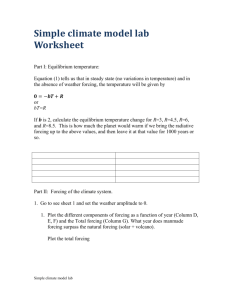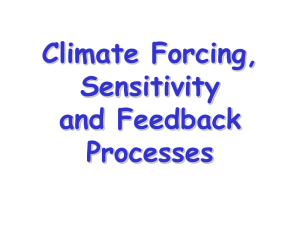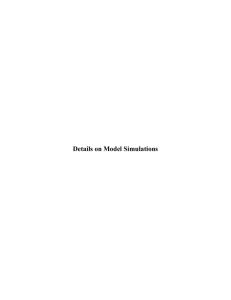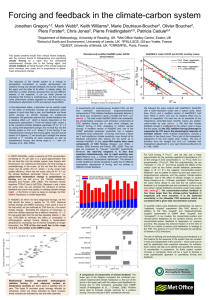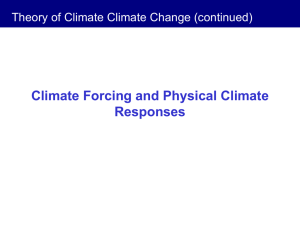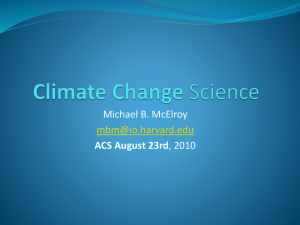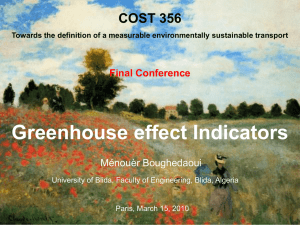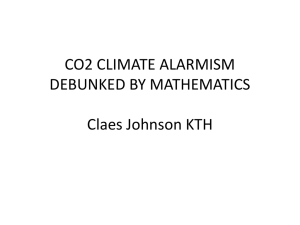bT=R - UW Program on Climate Change
advertisement
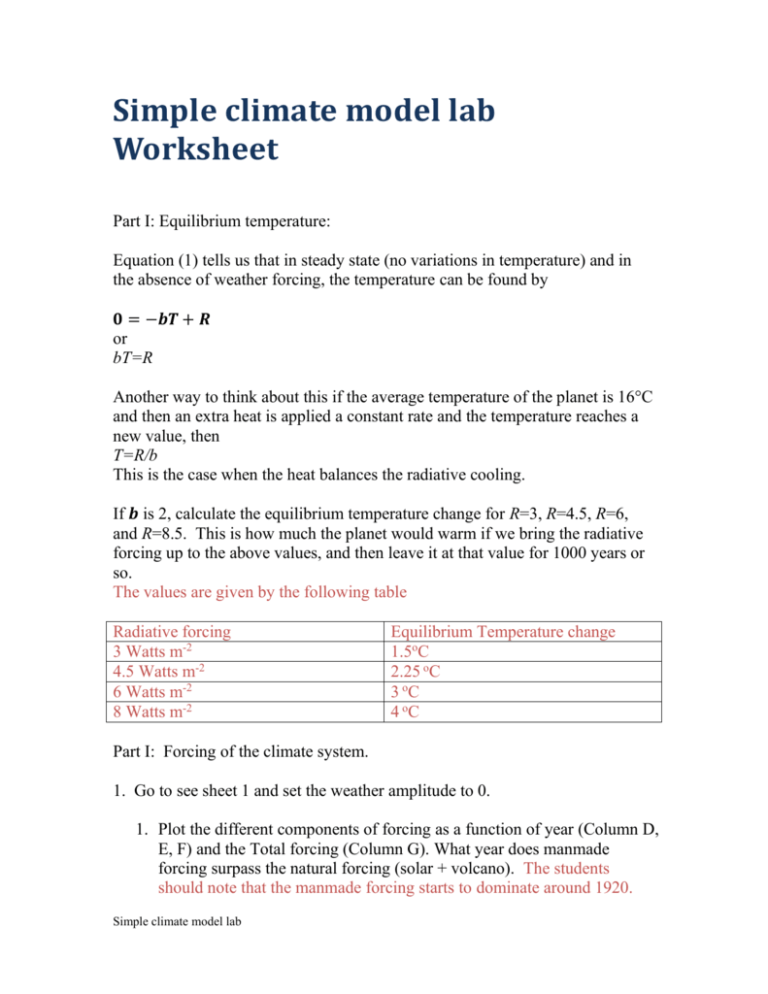
Simple climate model lab Worksheet Part I: Equilibrium temperature: Equation (1) tells us that in steady state (no variations in temperature) and in the absence of weather forcing, the temperature can be found by 𝟎 = −𝒃𝑻 + 𝑹 or bT=R Another way to think about this if the average temperature of the planet is 16°C and then an extra heat is applied a constant rate and the temperature reaches a new value, then T=R/b This is the case when the heat balances the radiative cooling. If 𝒃 is 2, calculate the equilibrium temperature change for R=3, R=4.5, R=6, and R=8.5. This is how much the planet would warm if we bring the radiative forcing up to the above values, and then leave it at that value for 1000 years or so. The values are given by the following table Radiative forcing 3 Watts m-2 4.5 Watts m-2 6 Watts m-2 8 Watts m-2 Equilibrium Temperature change 1.5oC 2.25 oC 3 oC 4 oC Part I: Forcing of the climate system. 1. Go to see sheet 1 and set the weather amplitude to 0. 1. Plot the different components of forcing as a function of year (Column D, E, F) and the Total forcing (Column G). What year does manmade forcing surpass the natural forcing (solar + volcano). The students should note that the manmade forcing starts to dominate around 1920. Simple climate model lab 2.500 2.000 1.500 1.000 Volcano 0.500 0.000 1850 -0.500 Solar 1900 1950 2000 2050 Manmade -1.000 -1.500 -2.000 Plot the total forcing Total = (manmade+solar+ volcano +weather) 2.500 2.000 1.500 1.000 Total = (manmade+solar+ volcano +weather) 0.500 0.000 1850 -0.500 1900 1950 2000 2050 -1.000 -1.500 2. Make a plot of the carbon dioxide concentration as a function of time (note change the axis to start at 280 ppm). Comment on the relationship between the manmade forcing and the carbon dioxide concentration. The students should say that the curves look very similar. Simple climate model lab Carbon dioxide concentration (ppm) 4.00E+02 3.80E+02 3.60E+02 3.40E+02 Carbon dioxide concentration (ppm) 3.20E+02 3.00E+02 2.80E+02 1850 1900 1950 2000 2050 3. Now go to the other sheets RCP3, RCP45, RCP6 and RCP85 and make a plot of the total forcing on the same graph. What are the values at 2100? What are the wiggles in each of the lines? 9.000 8.000 7.000 6.000 Manmade forcing +solar 5.000 Manmade forcing +solar 4.000 Manmade forcing +solar Manmade forcing +solar 3.000 2.000 1.000 0.000 2000 2020 2040 2060 2080 2100 2120 The students can note that the RCP name is related to the radiative forcing at the end of the century. Simple climate model lab The wiggles are the 11 year solar cycle that we assume continues without change into the 21st century. Part II: Controls of surface temperature 1. The first thing to explore is how the ocean controls temperature changes on the earth. Before we begin, determine much energy it would take to warm up the atmosphere by 1°C. To do this calculation you need The mass of the atmosphere per square meter: Ma=10,000 kg/m2 Specific heat of air cp air = 1006 Joules/kg/K Energy needed E= Ma X cp air X 1K E=10,000,006 Joules/m2 Next, determine the depth of the ocean that could be heated 1K using the amount of energy that you calculated above The density of sea water is ρ=1025 kg/m3 The specific heat of sea water is cp ocean= 3985 Joules/kg/K 10,000,006=ρ X cp ocean X H X 1K where H is the thickness of ocean Check your units Joules/m2= kg/m3 X Joules/kg/K X m X K Joules/m2= Joules/m2 Solve for H to get H=10,000,006/(ρ X cp oceanX 1)=2.5 m (!) 2. Go to sheet 1 (1880-2006). Set the weather forcing to 0 and the sensitivity parameter to 2 and the depth of the ocean to 300 m. Save the Simple climate model lab results in column H in another workbook or sheet (use paste special to paste the values without the formula) Change the sensitivity parameter to 0.5 and save the results in column H Change the sensitivity parameter to 4.0 and save the results in column H Plot the three temperatures on the same plot. How does the surface temperature in 2005 depend on the sensitivity parameter? 1.800 1.600 1.400 1.200 1.000 Climate sensitivity 2 0.800 Climate sensitivity 0.5 0.600 Climate sensitivity 4 0.400 0.200 0.000 1850 -0.200 1900 1950 2000 2050 The students should see that the temperature at the end of the century is be proportional to the inverse of the climate sensitivity parameter as we also found in the equilibrium solution 1. Set the sensitivity parameter to 2, and change the depth of the upper ocean to 1000 m, and record the surface temperature in 2005. Do the same for depth of the upper ocean to 50m and record the surface temperature. How does the surface temperature depend on the depth of the ocean? Simple climate model lab 1.2 1 0.8 0.6 Depth 300 m 0.4 Depth 50 m Depth 1000 m 0.2 0 1860 -0.2 1880 1900 1920 1940 1960 1980 2000 2020 -0.4 There are two things to notice, the temperature at the end of the century is larger for shallower oceans, and second that the shallower ocean adjusts more quickly to changes in forcing and tracks the forcing curve more closely. Part III: Simulation of 20th century temperature, natural vs. anthropogenic forcing 3. Set the sensitivity parameter to 2, the depth of the upper ocean to 300 and the weather forcing to zero. Plot the observed surface temperature (column K) and the temperature from natural (column I) and total forcing (column H) on the same graph. Which curve compares better with the observed temperature. What is missing? The students should note that there is interannual variability (or wigglyness) in the observed temperature. That is missing from the modeled temperature records. Simple climate model lab 1.000 0.800 Temperature from manmade +solar +volcano +weather 0.600 Temperature from solar +volcano +weather 0.400 Observed Temperature 0.200 0.000 1850 1900 1950 2000 2050 -0.200 4. Now add weather forcing. Change the weather forcing parameter to 2. Do the curves look more similar? How? 5. Now add weather forcing. Change the weather forcing parameter to 2. Do the curves look more similar? How? Simple climate model lab Part IV: Predicting the surface temperature for the next 300 years. The predicted radiative forcing is given by the amount of anthropogenic greenhouse gases in the atmosphere and how the atmosphere radiates and absorbes that radiation, how cloud react to warming and other feedbacks in the climate system. We are taking the radiative forcing from the web site http://www.pik-potsdam.de/~mmalte/rcps/. 1. Vary the weather parameter and the sensitivity parameter to get the best representation of the 20th century as you can. Use the 300 for the depth of the upper ocean. Plot your best simulation for globally averaged temperature for total forcing and for natural forcing only. Compare against the plot found at http://www.climatechange2013.org/images/figures/WGI_AR5_FigFAQ1 0.1-1.jpg (note: figure caption in WG1AR5_Chapter10.pdf) I used b=1.8 and weather =2.1 Also, the students can note that every time a new run is done, the random forcing changes. 2. Using the weather parameter and the sensitivity parameter that you chose for the 20th century, predict the temperature for the next 100 years. Plot your predictions for each of the “scenarios” in sheets 2-5. Compare against the 2007 projections at 2100 http://www.climatechange2013.org/images/figures/WGI_AR5_FigTS15.jpg Simple climate model lab (note: figure caption in WG1AR5_TS_FINAL 57.pdf) 4 3.5 3 Temperature from RCP3 2.5 2 Temperature from RCP45 1.5 Temperature from RCP6 Temperature from RCP8 1 0.5 0 2000 2050 2100 2150 3. Next determine how close to equilibrium the climate system is. Set the weather noise to 0 and use the value for b that you chose for 1 above. Record the temperature for each of the cases listed in the Table below then answer the following questions: How far out of equilibrium (in degrees C) is the climate system out of equilibrium in 2005? How far will it be out of equilibrium in 2100? The students can note that the more rapidly we introduce carbon dioxide into the atmosphere, the more out of equilibrium the climate system is. Simple climate model lab Value of b 1.8 Date Transient total forcing Equilibrium total forcing RCP3 Transient RCP3 Equilibrium RCP 45 Transient RCP 6 Transient RCP 6 Equilbrium RCP 6 Transient RCP 8.5 Equilibrium RCP 8.5 Transient Simple climate model lab Temperature 2005 Radiative forcing Parameter 1.994 2005 1.994 1.11 2100 2100 2.6 2.6 1.473 1.44 2100 4.281 2.033 2100 2100 4.281 5.552 2.378 2.424 2100 2100 5.552 8.34 3.084 3.497 2100 8.34 4.633 0.737
